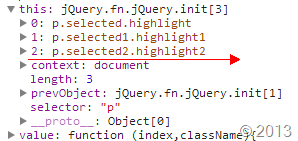通过给元素添加删除指定的样式类名用来修改样式的方法有 addClass 与 removeClass,为每个匹配的元素添加指定的样式类名,对元素的样式操作,底层的实现就是修改元素的className值,实现的功能:
增加一条样式规则: .addClass('myClass')
增加多条样式规则: .addClass('myClass yourClass')
传递回调遍历样式规则:
$("ul li:last").addClass(function(index) {
return "item-" + index;
});
从接口传参去分析这个实现手法,参考右边的代码addClass我把代码简略的分了几个步骤:
/\S+/g 空白分组这里就不详讲,看看代码就能理解重点说一下传递回调函数的设计,官方给的测试案例:
<p class ='selected highlight'>Goodbye</p> <p class ='selected1 highlight1'>Goodbye</p> <p class ='selected2 highlight2'>Goodbye</p>
增加样式代码:
$(p).addClass(function(index,className){
index className
0 "selected highlight"
1 "selected1 highlight1"
2 "selected2 highlight2"
});
遍历出所有的 P 节点,并找其对应的 class,返回给每一个回调函数,看看源码的设计:
//如果传递的是回调函数,递归调用 ⑴
if ( jQuery.isFunction( value ) ) {
return this.each(function( j ) { //each addClass回调
jQuery( this ).addClass( value.call( this, j, this.className ) );
});
}
不管是写插件还是其他的,只要是设计操作 DOM 的,在 jQuery 内部就的到 this.each 方法,原因很简单jQuery就是一个数组保存着所有对应的节点的下标。

内部在传递一个编写好的回调函数,传递给 each 方法 ,each 方法理解就是一个循环方法,分解出 jQuery 数组中每一个下标元,然后把每一个元素返回给外部回调。

这里再进一步替换下代码就很明显了:
function( i, obj[ i ] ) {
jQuery( this ).addClass( value.call( this, j, this.className ) )
}
这里的 this 是指向的每一个 p 元素节点,因为 callback.call 了一下,把每一个上下文指定到当前的函数了,所以 this 就是对应的 obj[i],最后执行的代码就是:
value.call( this, j, this.className )
value 就是最外层用户定义的回调了,复制代码:
$(p).addClass(function(index,className){
// index className
// 0 "selected highlight"
// 1 "selected1 highlight1"
// 2 "selected2 highlight2"
});
这里意外的发现 jQuery Api没给出还包装了一层 jQuery( this ).addClass ,那么意味着 jQuery 还可以接受用户最外层的返回参数,然后再调用 addClass 给当前节点增加新的类名:
jQuery( this ).addClass( value.call( this, j, this.className ) );
p.addClass(function(index,className){
return 'aaaa'
});

请验证,完成请求
由于请求次数过多,请先验证,完成再次请求
打开微信扫码自动绑定
绑定后可得到
使用 Ctrl+D 可将课程添加到书签
举报

实战

实战

实战

实战

实战